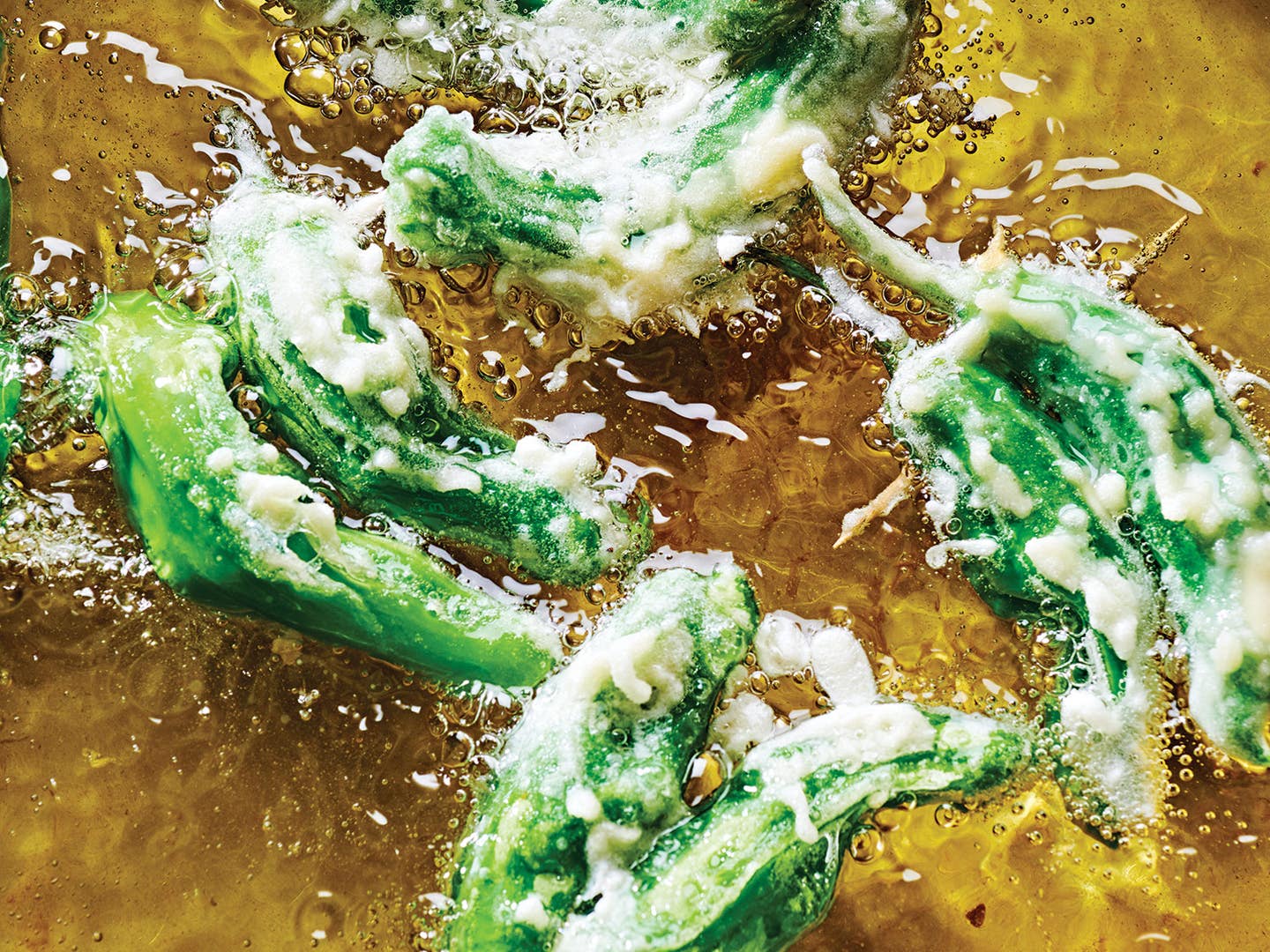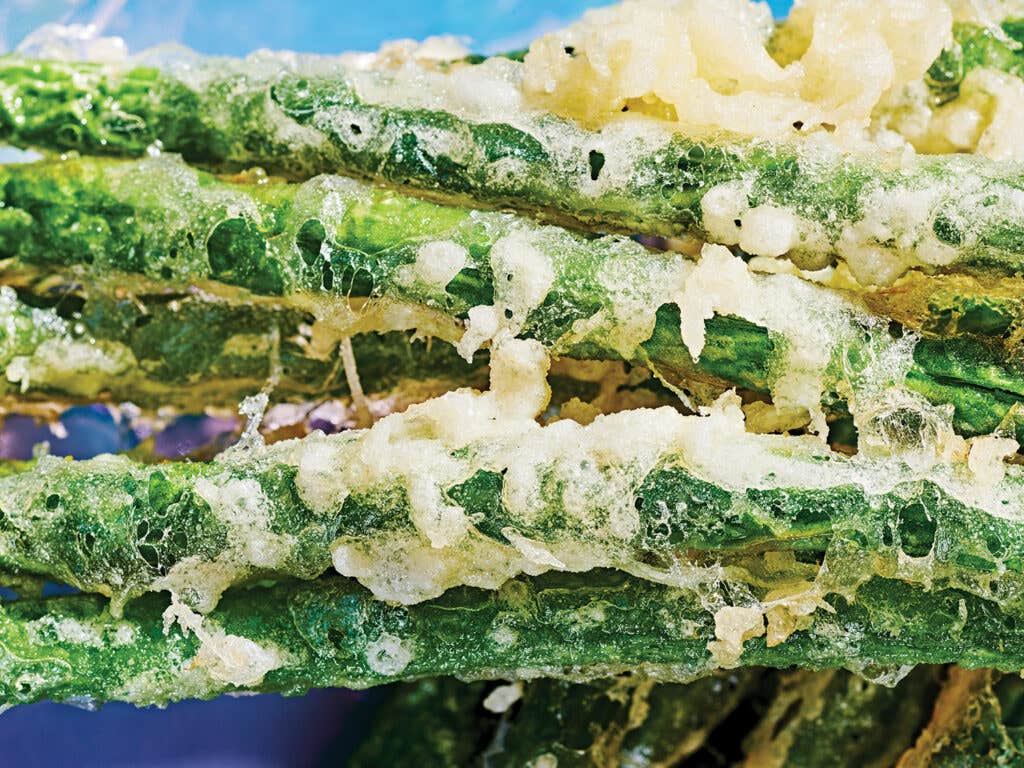
Japanese Tempura Is Our New Favorite Dinner Party Project
Gather around the stove and turn the best of your summer bounty into a battered-and-fried, eat-as-you-go feast
At its very best, vegetable tempura is piping hot and airy crisp, without a hint of heaviness or oiliness. And at its worst, it is a questionable soggy fry-up strewn atop a bowl of rice. While there are plenty of examples of the latter to be found in subpar interpretations worldwide, techniques borrowed from the tempura temples of Tokyo can lead you to easy mastery of one of Japan’s best dishes.
In the 16th century, when an early thick-battered version of tempura was introduced to Japan, likely by the Portuguese, oil was not yet being widely used in the country's cooking. Since extraction methods at the time produced so little oil—usually sesame—it was extremely costly and reserved mostly for use at banquet meals. Once oil-extraction methods improved toward the end of the Edo era, in the 18th century, tempura joined sushi and soba as an inexpensive food served at both popular restaurants and roadside stalls.

Over the years, tempura (along with sushi and soba) continued to be refined, and today it can be found at some of the highest-level restaurants in Japan. But one thing that has not changed is the cooks’ aversion to too-oily tempura. Fumio Kondo, chef at Tokyo’s two-star Michelin restaurant Tempura Kondo, says tempura should be regarded as a method of steaming ingredients, not deep-frying them. He believes that lightly dusting the ingredients in flour before dipping them into a wet batter helps to create a perfect gap for steaming the vegetables to firm-tender perfection while the outer batter fries and crisps.
Historically, the Japanese have not included much meat in their diets; and while seafood tempura may be used to punctuate a formal coursing in restaurants, vegetables are largely still the main attraction. Though enjoying a well-executed tempura meal at a restaurant can set you back $100 or more (plus a plane ticket to Japan), preparing it at home from some in-season vegetables is not as difficult as you’d think. The first step? Rethinking how to serve tempura in a home kitchen. Rather than piling the freshly fried foods together high on a plate and serving them warm (at best) in the center of the table, if you fry and serve as you go, everyone can enjoy hot, crispy bites as they come out of the oil—even the cook.
Pop open some beers and turn your fry session into a party, because perched around a counter is the ultimate way to eat tempura at home.

4 Steps to Perfect Vegetable Tempura
Theories abound on how to achieve a lacy, featherlight tempura shell. For Tokyo-style tempura, use a 1-to-1 ratio of flour to water, forgo gimmicks, and employ these simple steps.
1. Sift the Flour
Chefs Yokota and Kondo suggest using cake flour for the lightest tempura batter. Its naturally lower protein content helps minimize gluten formation, helping to keep the exterior delicate, not chewy. Sifting helps prevent caked-up masses.
2. Consider the Dry Dredge
Not every Japanese tempura chef adds this step, but Kondo believes it helps lend crunch to the fried batter while protecting the vegetables from absorbing too much oil. Use thick chopsticks to very lightly dredge the vegetables (one by one, or in small groups) in sifted cake flour before wet-battering them and frying.
3. Treat Each Vegetable Uniquely
Once your batter is thin (like that for a crêpe) with tiny lumps of flour (a good thing), prepare the vegetables according to their individual properties. Keep kabocha squash in large pieces so the interior cooks to a fluffy consistency. Dip and fry small or thin items such as corn kernels and green beans in clusters. Skewer shishito peppers in pairs, and batter only one side to keep colors vibrant. And partially slice eggplant to shorten its cooking time.
4. Monitor Oil Temperature
Fragile, lacy tempura that’s not soggy, doughy, or bronzed is about controlling the temperature of the frying oil. Kondo’s method uses room-temperature (not iced) water so as not to overly cool down the oil during frying. When you add the vegetables to the oil, you should see lots of active, tiny bubbles—they’ll elicit almost a high-pitched sound—indicating that the moisture from the vegetables is escaping, he says. When the bubbles subside and the tone gets lower, the tempura is done.
Keep Reading
Continue to Next Story










